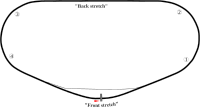 | |
 | |
| NASCAR Cup Series | |
|---|---|
| Venue | Daytona International Speedway |
| Location | Daytona Beach, Florida, United States |
| Corporate sponsor | Bluegreen Vacations[1] |
| First race | 1959 |
| Distance | 150 miles (241.401 km) |
| Laps | 60 |
| Previous names | 100 Mile Qualifying Races (1959–1967) 125 Mile Qualifying Races (1969–1980) UNO Twin 125 Qualifiers (1981–1984) 7-Eleven Twin 125's (1985–1987) Twin 125 Qualifiers (1988–1990) Gatorade Twin 125 Qualifiers (1991–1993) Gatorade Twin 125's (1994–1996) Gatorade 125's (1997–2004) Gatorade Duel (2005–2012) Budweiser Duel (2013–2015) Can-Am Duel (2016–2018)[2] Gander RV Duel (2019)[3] |
| Most wins (driver) | Dale Earnhardt (12) |
| Most wins (team) | Hendrick Motorsports Richard Childress Racing (16) |
| Most wins (manufacturer) | Chevrolet (53) |
| Circuit information | |
| Surface | Asphalt |
| Length | 2.5 mi (4.0 km) |
| Turns | 4 |
The Bluegreen Vacations Duel, formerly known as the Twin 125s,[4] is a NASCAR Cup Series preliminary event to the Daytona 500 held annually in February at Daytona International Speedway. It consists of two 150-mile (240 km) races, which both serve as a qualifying race for the Daytona 500. The finishing order in the two 150-mile (240 km) races, held on the Thursday before the Daytona 500, determine the starting lineup for the Daytona 500 held on race day.
Qualifying for the Daytona 500 is unique in NASCAR. Only the two front row starters (the pole and "outside pole") are determined by the standard knockout qualifying system. For all other drivers it only determines their starting position in their Duel, with odd placed cars being entered into the first Duel and even placed cars going in the second. After the Top 2 positions are locked in, the next 30 places of starting grid of the Daytona 500 is set by the finishing order of these two races with the top 15 (excluding pole winner and outside pole) making up the next 15 places on the inside and outside lanes respectively. After the Duels are completed the four fastest non-qualifiers by time and finally the six or seven (if no past champion's exemption is needed) highest-earning teams in points (from the previous season's standings) not in the race yet advance (also set by time), and the starting grid for the Daytona 500 would then be set. The order is still subject to change if technical regulations are violated.
- ^ "Bluegreen Vacations to sponsor NASCAR Cup Series Duel Races at Daytona". NASCAR. November 22, 2019. Retrieved November 22, 2019.
- ^ Turner, Jared (September 19, 2015). "New title sponsor named for Daytona 500 qualifying races in 2016". Foxsports.com. Retrieved September 19, 2015.
- ^ McFadin, Daniek (January 30, 2019). "Gander RV to sponsor Daytona 500 qualifying races". NBC Sports. Retrieved January 30, 2019.
- ^ Newton, David (February 24, 2012). "Next year's Daytona 500 is Feb. 24". ESPN.com. Retrieved February 24, 2012.